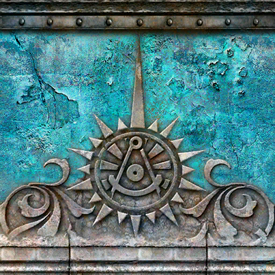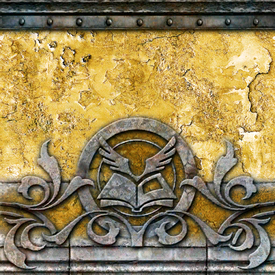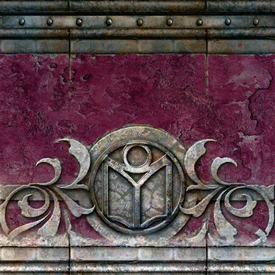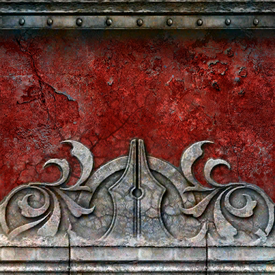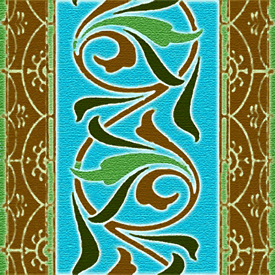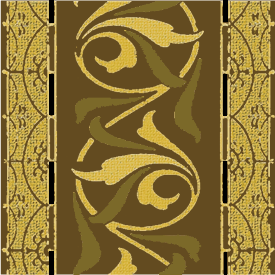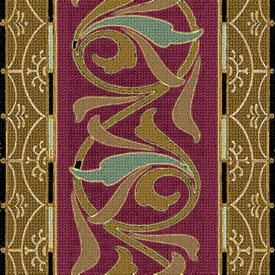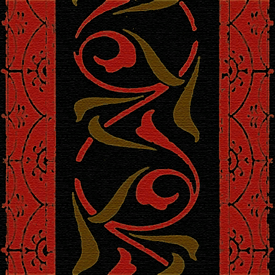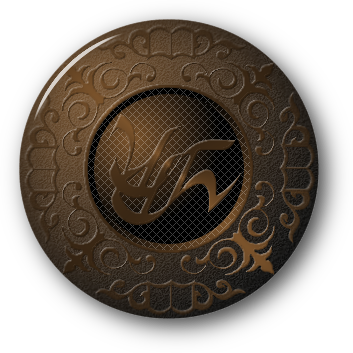

|
|
The D'ni guilds were the major economic and social engines of D'ni society. After the abdication of King Kerath, five guild masters became the city council, a new system of government that Kerath developed and which replaced the monarchy. The council technically was a regency that was to rule D'ni until the coming of the "true Great King", as Kerath had been raised by his mother to believe that King Ahlsendar was not the Great King of prophesy. Memberships in the major guilds were usually restricted to the rich and noble, but it was possible for both men and women to join minor guilds after completing fifteen years of primary education. Male children of members of the major guilds were automatcally granted entrance. Such children were taken from their families and inducted at the age of four, and were schooled by the guild. Female children were not eligible for membership in the major guilds, although they could join a minor guild after the normal fifteen year education. There were eighteen major guilds established after D'ni was founded, based on the guild structure of Ronay. The Guild of Writers was the most prestigious of the guilds, because the ability to create Ages was thought of as both a great privilege and an equally great responsibility. Guild laws and organization helped ensure that all Writers were trained to follow the rules thought necessary to write Ages that were both stable and safe. When the D'ni moved to the cavern, setting up the Guild of Writers was one of their first priorities, even before the construction of the Temple of Yahvo, and came second only to the building of the Great Zero. The guild's buildings were completed in the eighth year of the D'ni Era (7649 BC), and the opening of the guild was cause for celebration. Forever after, the anniversary of the opening of the Writer's Guildhall was a day of note on the D'ni calendar. The construction of the last of the eighteen major guildhalls were completed in DE 100, and they were dedicated to the service of Yahvo on Leenovoo 18 (April 8th, 7556 BC). This event was called The Day of the Circle. The guilds were ruled by a Grand Master. There were many Guild Masters, who supervisored the lower ranks or were assistants of the Grand Master. Below them were the Guild Captains. The rank and file were made up of the guildsmen and the guild apprentices. When King Kerath abdicated, he formed a regency government made up of a council of five Grand Masters of the eighteen major guilds, who were in turn elected by the eighteen major guilds. In time, it was decided to expand the council so that all of the major guilds were represented equally. Each of the eighteen guild council seats were filled by a Master who was elected from among his guild to represent them. Only one of the Guild Masters from a guild was elected to the Council. The original five seats were kept, but the Grand Masters who held them were required to retire from their guild, and were instead given the title Great Lord. A new Grand Master was appointed to replace them after they ascended to the seat. The Great Lords were still often referred to as Grand Masters of their guilds, although that was no longer an accurate title. Their actual title was simply Great Lord, and they no longer had any authority over their former guilds, except what was due to them out of respect and reverence. When a Great Lord died, a replacement could come from any of the eighteen major Guilds. At the time Anna dicovered D'ni, the Great Lords were alumnae of the Guilds of Writers, Miners, Books, Ink-Makers, and Maintainers. How the replacement was chosen — whether it was seniority, age, popularity, some kind of vote, or another method — is not clear from what we currently know of D’ni history. As a guess, it was probably a vote of the council, but that could be wrong. Significant events In DE 1124 ( 6533 BC), King Mararon decreed a number of major revisions to educational system. Common Schools in the various residential districts were placed under the authority and guidance of the Guild of Legislators. The number of years of compulsory education were increased from six to fifteen, after which students could enter one of the newly-established minor guilds. In DE 1975 (5682 BC), King Me'erta attempted to change the Writer's Guild Oath written by Ailesh at the urging of his mother, Jolatha, in an attempt to make them swear to serve the interests of the throne. Grand Master Writer Tremal objected, and was assassinated. This caused the Writer's Guild members to close ranks and refuse to change the Oath. In DE 2350 (5307 BC), the Minor Guild of Miners were encouraged by King Hemelin to innovate and improve their methods and technologies for extracting ores, creating building materials, and excavating new living spaces. In DE 2488 (5169 BC) they completed successful tests of a new technology, stone extrusion. This was considered to be so important that the Guild was raised from Minor to Major status. In order to maintain the eighteen major guild limit, the Major Guild of Fine Artists was dissolved and its members split into the Minor Guilds of Sculptors, Artists, Actors, and Musicians. This was not protested by the Guild of Fine Artists, because the split actually benefitted them. Each branch of the fine arts gained its own funding, heirarchy, and patronage, instead of having to campaign for attention from the same leadership. In DE 2504 (5153 BC), the Guild Council Chambers were completed. The new hall was constructed atop the Tomb of the Great King, making the Tomb barely visible. The Chamber included a hidden vault where King Naygen stored much of the royal treasury. When the Guild of Miners were elevated to major guild status, they began building a new headquarters for themselves. In DE 2580 (5077 BC), the new facilities were completed using extrusion technology. This was, rather appropriately, the first use of the method. In DE 2916 (4741 BC), the Mechanist's Guild expanded on the work of the Miners and developed industrial extrusion. This was a refined technology that lead to improved construction methods such as unistructural buildings, a technique in which large stone expanses were joined almost seamlessly. In DE 3500 (4157 BC) women made eligible for Minor Guild educations for the first time in D'ni or Ronay history. This enormous stride forward in the status of women in D'ni society took a heavy blow in DE 3523 (4134 BC), when Shama, the wife of King Ti'amel, successfully convinced the Guild Council to not allow women into the major guilds. This was strange because Shama had been the one who pushed through the idea that they should be allowed into the minor guilds. In DE 3961 (3696 BC), the Minor Guild of Illusionists was established. Relyimah ("The Unseen") was simultaneously created as a secret state police agency, and the Illusionist's Guild was used as its cover. In DE 4721 (2936 BC), the Major Guilds were forced to accept some students who passed entrance exams but could not afford their ever-growing membership fees. In DE 4826 (2831 BC) the first scholarship students of the Guild of Stone Masons devised an early fusion-compounding technology, which proved to be the first step toward the invention of nara, a greenish-black synthetic stone with a metallic sheen. Nara had thirty times the density of steel, and was used to coat and reinforce excavation sites. tunnels, and for some buildings. In DE 5043 (2614 BC), Faresh was appointed as head of the Illusionist's Guild by King Yableshan. His real purpose was to clean up Relyimah, which had gained a poor reputation regarding the ways it conducted its operations. Faresh began construction of a mansion of illusions on Katha island which came to be known as the Mystery House, and which also eventually became the headquarters of Relyimah. In DE 5236 (2421 BC), Deretheni was first produced in a lab by the Guild of Stone Masons. Deretheni was a jet-black lightweight stone. It was molecularly altered for strength, and was another step on the path to the creation of nara. In DE 5307 (2350 BC), Nara, the hardest of all D'ni stones, was produced in the lab by the Guilds of Stone Masons and Miners as a cooperative effort. In DE 5473 (2184 BC), deretheni was adopted and used by the Maintainer's Guild to construct improved armored environmental suits. This meant that Writers could be more experimental with their Ages, since Maintainers were better protected. Deretheni was used to completely cover heavy environmental armor for the first men to enter a new Age, and was also used in the helmets and armor plates on the Maintainer's normal working suits. The hydraulic rods that give the suits their flexibility were made of the same material. In DE 6970 (687 BC), construction began on a new Guild Council Hall, further burying the Tomb of the Great King. This was the last major event in the history of the Guilds before the Fall. Known Major Guilds This is a list of the eighteen major guilds at the time of the Fall, in order of their importance, along with their guild colors and Ages known to be owned by them. The only difference between this list and the list of eighteen major guilds after the founding of D'ni was that the Guild of Fine Artists was on it, and the Miners were a minor guild.
Each guild had their own unique insignia and color. Official guild robes and formal cloaks were dyed in the guild's colors. Major Guilds also had their own meeting halls where members lived and worked, though members with families might also own their own houses. Guildhalls could be single buildings, or entire complexes of buildings for the larger guilds such as the Writers or Maintainers. Some of the larger and more important Guilds had their own Ages, such as Gahreesen, which belonged to the Maintainers, and Birenni, which belonged to the Healers. Members were expected to abide by Guild rules and have a sense of pride for their Guild. Violation of Guild Rules could result in expulsion, as in the case of A'gaeris. These are four representative samples of the colors and symbols of the guilds. They are, from left to right, the Cartographers, Messengers, Maintainers, and Writers.
Minor Guilds Not very much is known of the minor guilds, other than that there were a great many of them. None of their members were eligible to serve on the D'ni Council. Among the minor guilds were the Guild of Actors, Guild of Architects, Guild of Artists, Guild of Bankers, Guild of Educators, Guild of Illusionists, Guild of Musicians, and the Guild of Sculptors. It is probably safe to say that D'ni life revolved around guilds, and it's likely that every profession was tied to one, except for unskilled labor. The closest comparable thing in modern society might be labor unions, although unions do not have the cradle-to-grave pervasiveness or influence of a D'ni guild. Guild Hierarchy Even though each Guild had their own traditions, each Guild (presumably) operated under the same basic hierarchical structure. Members were inducted into service at a very young age. When they completed their training they attained the rank of Guildsman. Each Guild had numerous Guild Masters who had served for many years, and each Guild was lead by a Grand Master. The five ranks in a D'ni guild were, in descending order: Grand Master |
||||||||||||||||||||||||||||||||||||||||||||||||||||||||||||||||||||||||||||||||||||||||||||||||||||||||||||||||||||||||||
Myst, the Myst logo, and all games and books in the Myst series are registered trademarks and copyrights of Cyan Worlds, Inc. Myst Online: Uru Live is the sole property of Cyan Worlds Inc. The concepts, settings, characters, art, and situations of the Myst series of games and books are copyright Cyan Worlds, Inc. with all rights reserved. I make no claims to any such rights or to the intellectual properties of Cyan Worlds; nor do I intend to profit financially from their work. This web site is a fan work, and is meant solely for the amusement of myself and other fans of the Myst series of games and books. |
